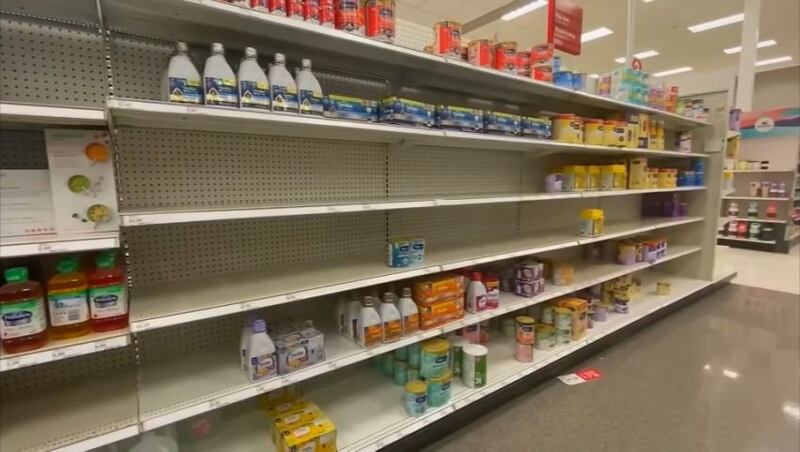WASHINGTON — The nationwide baby formula shortage continues to worsen, leaving families to try to find ways to stock up on limited supply.
It’s an alarming trend in the state of Washington and beyond. Shelves are empty, online stock is low, and formula in general is hard to find.
“I hope the solution comes up soon because it’s hard,” Jane Ndungu told KIRO7 from her home in south Everett.
Having a low supply of breast milk, Ndungu has always supplemented her son’s diet with formula.
Now she is doing everything she can, both in person and online, to try to keep her 11-month-old, Jeremy, fed.
“It’s a guessing game,” she said, as she described how she currently goes about finding formula.
Ndungu started noticing formula shelves were running bare at the beginning of April.
She visited five stores and came away empty-handed.
Then, she looked on Amazon and was able to find three cans of Similac, the formula her son takes. She paid $157, which she said is at least $30 over what she used to pay pre-shortage, but she didn’t want to find herself without formula again, so she put in for a subscription to receive three cans per month at the elevated price.
But her next order never came.
“I received a message that they were out of stock and they couldn’t find it anywhere,” Ndungu said.
Now, nearly every day, she goes store-to-store to try to find more. Typically, Ndungu said she can find a small can, but it’s not enough and it’s expensive.
“It’s frustrating, very frustrating because there’s nothing you can do,” Ndungu said.
Those frustrations are shared by thousands of families currently impacted by the shortage.
According to Datasembly, as of April 3, 2022, Washington was one of seven states experiencing an out-of-stock rate for formula that was higher than 40%, while the rest of the nation averaged 31%.
Then, in just three weeks, the nationwide average caught up to Washington. Recent projections from Datasembly now show 26 states are now struggling with a 40-50% deficit in supply.
“This is hard for all moms, and we need to look for a solution about how the supply can get better, because babies have to eat, babies have to have the formula, not all moms are able to breastfeed,” Ndungu said.
The shortages have been caused by pandemic-related supply chain issues and a recent recall.
On Tuesday, the Food and Drug Administration said it is already acting and working with manufacturers to try to increase production and output, while also helping to expedite imports.
A statement on the FDA’s website reads in part:
“We recognize that many consumers have been unable to access infant formula and critical medical foods they are accustomed to using and are frustrated by their inability to do so. We are doing everything in our power to ensure there is adequate product available where and when they need it,” said FDA commissioner Robert M. Califf. “Ensuring the availability of safe, sole-source nutrition products like infant formula is of the utmost importance to the FDA. Our teams have been working tirelessly to address and alleviate supply issues and will continue doing everything within our authority to ensure the production of safe infant formula products.”
Still, retailers are left to stretch their already limited supply. Major retail chains like Target, CVS and Walgreens have placed purchasing limits on formula items.
In response to the shortage, parents are going to great lengths to find formula — even joining breastmilk and formula sharing Facebook groups to try to buy, sell or trade for supply.
Other parents are taking a DIY approach and attempting to make their own formula at home.
In February 2021, the FDA warned parents not to create their own formula because it has not been evaluated by the FDA, may contain contaminants, and “may lack nutrients vital to an infant’s growth.”
The agency continued, saying, “the consequences could range from severe nutritional imbalances to foodborne illnesses, both of which can be life-threatening.”
Dr. Steven Abrams, former chair of the American Academy of Pediatrics Committee on Nutrition, advises that the best option for parents or caregivers is to find a different formula that is most similar to the one your child currently takes.
If you don’t know which formula is the closest match, or if your baby needs a specialized formula, Abrams recommends speaking to your pediatrician.
He also asks parents to keep in mind that babies may get an upset stomach as they adjust to a formula change, but typically, that is something that they will get used to.
Milk banks have also caught wind of the shortage, although the service is typically reserved for hospitals and babies with medical needs.
“There are a lot of families that are quite worried,” said Joanne Ransom, nurse and clinical director for Northwest Mothers Milk Bank, the only milk bank which services the Pacific Northwest.
Ransom said as the formula shortage continues, they expect to see an uptick in inquiries. And while they won’t be able to directly service everyone, they can help point families in the right direction.
“We will do what we can to help support families,” said Ransom. “It must be very frightening for them to not know how they are going to feed their babies.”
Ransom said as the shortage continues, she encourages women with a surplus of supply to consider donating it.
According to the Centers for Disease Control and Prevention, nearly three-quarters of babies will eat formula at some point in their first six months of life.
Datasembly projects that the formula shortage will continue.
The Infant Nutrition Council of America is encouraging parents to keep a 10-day supply on hand, if possible.
©2022 Cox Media Group








